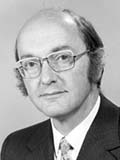Donald Davies

Davies played an instrumental role in the early evolution of the history of computer communications while Deputy Superintendent and Superintendent of the National Physical Laboratory (NPL), U.K. Realizing the value of a store-and-forward architecture for digital communications, years after Paul Baran, his use of the term “packet switching” would eventually name this new technology. Davies played many key roles including influencing such important contributors to computer communications as Louis Pouzin, Hubert Zimmerman, as well as Roger A. Scantlebury, K.A. Bartlett, P.T. Wilkinson, Gary Farber and Derek Barber all associated with the NPL.
As Davies shares in this interview, he had a long career with the NPL working with computers and solving communication problems. However, it was not until he attended the International Federation for Information Processing (IFIP) Congress in NYC in 1965 that he becomes important to the history of computer communications and specifically with packet switching. Davies recalls that at the IFIP Conference: “everyone was talking about Project MAC at MIT, and timesharing was all in the news.” After leaving the Congress, he visited MIT and remembers having a number of conversations about the communication issues involved with timesharing. Then on arriving at Heathrow, he met a friend, Brian Shackel, who suggested Davies arrange a meeting at NPL with some of the MIT scientists to discuss Project MAC. The two-day seminar was held on November 2nd & 3rd of 1965. Larry Roberts was one of the people present. The conversations inspired Davies, later at home over his kitchen table, to sketch out the concepts that would become packet switching.
When Davies met me at my hotel, he brought along a number of documents that made explicit his and the NPL’s efforts to made packet switching real. Davies first documented his thoughts in a memo dated November 10th,,1965. On the 15th of December he circulated a more “elaborate” paper. On March 16th, 1966, he gave a lecture at NPL to more than 100 people. After the lecture, Dr. A. Llewellyn, Director of the CAD Centre, offered to send him a copy of Paul Baran’s RAND report published in 1964. The contents of the lecture were later documented in a paper dated June 1966 (“Proposal for a digital communication network”); that contained the first use of the word “packet” - to distinguish between the message the user wanted to send and the smaller units used for transmission over the packet network - as well as introduced the concept of an “interface computer” to sit between the user equipment and the packet network. Although the Proposal met with surprising support, there was no organization like ARPA in the U.K. to create or fund such an experiment. When Davies was promoted to Superintendent of the NPL in August 1966, he now had the authority to initiate a pilot experiment within his lab to demonstrate the feasibility of a packet switch network. It was successful. Work then began to design what would become the NPL network - making it the world’s first operational packet switched network.
Keywords: packet switching, NPL, IFIP